Phobos (mythology)
Phobos ( ancient Greek Φόβος "fear, panic fear", Latin Pavor , also Metus ) is a daimon and god of Greek mythology .
Phobos usually occurs together with Deimos , "terror". Already in Homer's Iliad , both as retinues of Ares spread fear and terror among the fighters of Troy . Together with Deimos, he serves Ares, whom they harness the horses to the chariot. They also save the god of war wounded by Heracles from the battle and bring him to Olympus in a chariot . For Homer Phobos is the beloved son of Ares and probably Deimos was also for Homer son of Ares. For Hesiod they are together sons of Ares and Aphrodite , whom he calls Kythereia. In the Dionysiacs of the Nonnos of Panopolis , both are sons of Enyalios , an Epiklesis des Ares who is also venerated as an independent deity . They appear here not only as charioteers and companions of Ares in the fight against Dionysus , but also as assistants of Zeus , who lets them compete in his second fight against Typhon , equipping Phobos with the lightning bolt and Deimos with the thunderbolt. The Suda , a Byzantine lexicon that was probably created in the 10th century , names Phobos and Deimos together with Kydoimos , the daimon of hand-to-hand combat, sons of polemos , i.e. of war, and companions of Ares. According to Suda, they suffered the same fate as Ares, who tried to bring Hephaestus back to Olympus by force so that he could free Hera from her bondage on the throne. Unimpressed, Hephaestus chased the god of war away with firebrands.
The around 400 BC Acting poet Antimachos von Kolophon counted Phobos as well as Deimos to the four fire-snorting horses of Ares, probably as a result of a misinterpretation of the carriage scene by Homer. Also in the Argonautica of Valerius Flaccus are Pavor and terror, the Roman translations of Phobos and Deimos, the horses of the Roman god of war Mars (Martis equi) .
In the Iliad Phobos was depicted together with Deimos on the shield of Agamemnon and also the shield of Agamemnon depicted on the cypseloslade in the Olympic Heraion showed Phobos as a central motif, according to Pausanias with a lion-shaped head. An inscription described him: "This is the Phobos of mortals, he who bears him is Agamemnon." The shield of Heracles showed in the peripheral scenes both of them standing next to Ares on the chariot. In addition, the face of Phobos adorned the central field of the shield. It was terrible to look back on and eyes glowing with fire. His white teeth shone terribly and terribly. Eris ("argument") hovered over his grim brows . In Quintus of Smyrna finally decorate Phobos and Deimos next Enyo ( "melee") and Eris the shield of Achilles . But also on the Aegis of Athena Phobos could be seen next to the head of the Gorgon Medusa, according to Homer. However, the authenticity of the position is questioned and assessed as a subsequent insertion.
In Sparta there was a sanctuary with a small temple of Phobos, which, according to Plutarch, was near the Syssition of the Ephors . Plutarch gives the reason for the veneration of Phobos that the Spartans believed that the state was held together by fear, namely the fear of correction and humiliation. In essence, this Spartan Phobos is closely related to the Athenian Aidos , the "shy, modesty" and clearly differs from the son of Ares and his purely war-related nature.
After the companions of Ares, to whom the god Mars corresponds in Roman mythology, the moons of the planet Mars were given the names Phobos for the larger and Deimos for the smaller of the satellites.
literature
- Otto Höfer : Phobos . In: Wilhelm Heinrich Roscher (Hrsg.): Detailed lexicon of Greek and Roman mythology . Volume 3.2, Leipzig 1909, Col. 2386-2395 ( digitized version ).
- Ernst Bernert : Phobos 1. In: Paulys Realencyclopädie der classischen Antiquity Science (RE). Volume XX, 1, Stuttgart 1941, Col. 309-317.
- John Boardman : Phobos . In: Lexicon Iconographicum Mythologiae Classicae (LIMC). Volume VII, Zurich / Munich 1994, pp. 393-394.
- Harvey Alan Shapiro: Personifications in Greek Art. The Representation of Abstract Concepts, 600-400 BC Akanthus, Zurich 1993, pp. 208-215.
Web links
- Deimos in the Theoi Project (English)
Remarks
- ↑ Homer, Iliad 4,440 ( Memento April 7, 2016 in the Internet Archive ).
- ↑ Homer, Iliad 15,119 f.
- ↑ Hesiod , Shield of Heracles 458-465.
- ↑ Homer, Iliad 13,299 ( Memento April 7, 2016 in the Internet Archive ).
- ↑ Hesiod, Theogony 934 ; Scholien zu Homer, Iliad 4,439,440; 15.119.
- ↑ Nonnos, Dionysiaka 29,364 ff.
- ↑ Nonnos, Dionysiaka 27, 335 ff.
- ↑ Nonnos, Dionysiaka 32, 175.
- ↑ Nonnos, Dionysiaka 2,414 ff.
- ↑ Suda , keyword Δεῖμος , Adler number: delta 327 , Suda-Online .
- ↑ Scholion to Homer, Iliad 439.
- ↑ Valerius Flaccus 3.89.
- ↑ Homer, Iliad 11:37. ( Memento from May 31, 2010 in the Internet Archive )
- ↑ Pausanias 5,19,4 f.
- ↑ Hesiod, The Shield of Heracles 191–195.
- ↑ Hesiod, The Shield of Heracles 144-150.
- ↑ Quintus of Smyrna 5:27 ff.
- ↑ Homer, Iliad 5,739.
- ↑ Plutarch, Kleomenes 8.9.
- ↑ Plutarch, Kleomenes 9.
